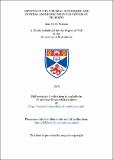Files in this item
Aspects of the visceral autonomic and central aminergic nervous system of teleosts
Item metadata
| dc.contributor.advisor | Cobb, James L. S. | |
| dc.contributor.author | Watson, Alan H. D. | |
| dc.coverage.spatial | 173 p. | en_US |
| dc.date.accessioned | 2018-07-05T14:35:21Z | |
| dc.date.available | 2018-07-05T14:35:21Z | |
| dc.date.issued | 1979 | |
| dc.identifier.uri | https://hdl.handle.net/10023/15006 | |
| dc.description.abstract | The structure of the autonomic innervation of the gastro-intestinal tract and heart of a number of teleosts was examined using light and electron microscopy and fluorescence histochemistiy. In the scorpion fish, the structure of the coeliac ganglion and the distribution of aminergic neurones in the brain was also investigated. The distribution of monoamine-containing nerves in the gut of scorpion fish, plaice, herring and ice fish was described using fluorescence histochemistry. Castecholaminergic fibres are found in the myenteric plexus and in the submucosa where they frequently run with blood vessels. They also supply the longitudinal muscle of the rectum and are often prominent in the circular muscle of the pyloric and anal sphincters. Serotonergic nerves pass through the submucosa to the subepithelial plexus and 5HT can be isolated chromatographically from gut wall homogenates. Serotonergic enterochromaffin cells are present in the stomach and distal rectum and in the herring a catecholamine-containing form was observed in the pyloric stomach. Ultrastructurally two types of axonal profiles are seen in the gut. The first contains small agranular vesicles typical of cholinergic nerves and these synapse with the perikarya of myenteric neurones, while the second contains a mixture of large and small granular vesicles and though often found adjacent to ganglion and muscle cells is not involved in conventional synapses. Both types are present in the subepithelial plexus. Histochemical and drug depletion studies suggest that some of the granular vesicles contain biogenic amines. The hearts of plaice, dab and angler fish do not contain adrenergic nerves Taut these were found in all other species examined. In the lingcod, aminergic perikarya are also present in the cardiac ganglion. With the electron microscope, the densest innervation of cardiac muscle was found close to the cardiac ganglion but though fluorescent nerves are abundant, nerve profiles contain predominantly agranular vesicles. The coeliac ganglion of scorpion fish is similar in structure to sympathetic ganglia in other vertebrates. It contains two types of principal cell as well as a population of small intensely fluorescent (SIP) cells. The SIP cells appear to become more numerous in early summer when vesicles in the equivalent cells observed ultrastructurally develop electron dense granules. The catecholaminergic and serotonergic structures in the brain of scorpion fish were described and compared to those of other teleosts and higher vertebrates. | en_US |
| dc.language.iso | en | en_US |
| dc.publisher | University of St Andrews | |
| dc.subject.lcc | QL638.S42W2 | en |
| dc.subject.lcsh | Teleostean fish biology | en |
| dc.title | Aspects of the visceral autonomic and central aminergic nervous system of teleosts | en_US |
| dc.type | Thesis | en_US |
| dc.contributor.sponsor | Natural Environment Research Council (NERC) | en_US |
| dc.type.qualificationlevel | Doctoral | en_US |
| dc.type.qualificationname | PhD Doctor of Philosophy | en_US |
| dc.publisher.institution | The University of St Andrews | en_US |
This item appears in the following Collection(s)
Items in the St Andrews Research Repository are protected by copyright, with all rights reserved, unless otherwise indicated.

